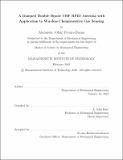A Damped Double Dipole UHF RFID Antenna with Application to Wireless Chemiresistive Gas Sensing
Author(s)
Peraire-Bueno, Alexander (Olek)
DownloadThesis PDF (10.12Mb)
Advisor
Hart, A. John
Terms of use
Metadata
Show full item recordAbstract
Ultra High Frequency (UHF) Radio Frequency Identification (RFID) tags provide an inexpensive framework for distributed sensing. Materials such as functionalized carbon nanotubes (CNTs) have been engineered to change in resistance when exposed to a variety of analytes. These materials have been added to RFID tags to create low cost sensors that work at a fixed reader-tag separation distance. This thesis proposes a novel approach to create UHF RFID sensing tags that work independent of distance (within the operating range), and are able to sense changes in resistance of a sensing element with a conductivity similar to that of CNT networks. Simulations of the proposed design show two methods of operation, either by comparing the damping between two resonant peaks, or by shifting the resonant frequency of the RFID tag. The first of the two methods of operation is validated experimentally with surface mount resistors, showing a relative change in 𝜏 of 0.2 for a 35% change in resistance of the sensing element. Then, a printing process is developed for liquid inks comprising CNTs, and RFID tags are fabricated with functionalized CNTs as the active elements. The functionalized CNTs exhibit an irreversible 65% change in resistance at 100ppm NH₃, resulting in the tags demonstrating a relative change in 𝜏 of 0.5 when exposed to 1000ppm NH₃.
Date issued
2022-02Department
Massachusetts Institute of Technology. Department of Mechanical EngineeringPublisher
Massachusetts Institute of Technology